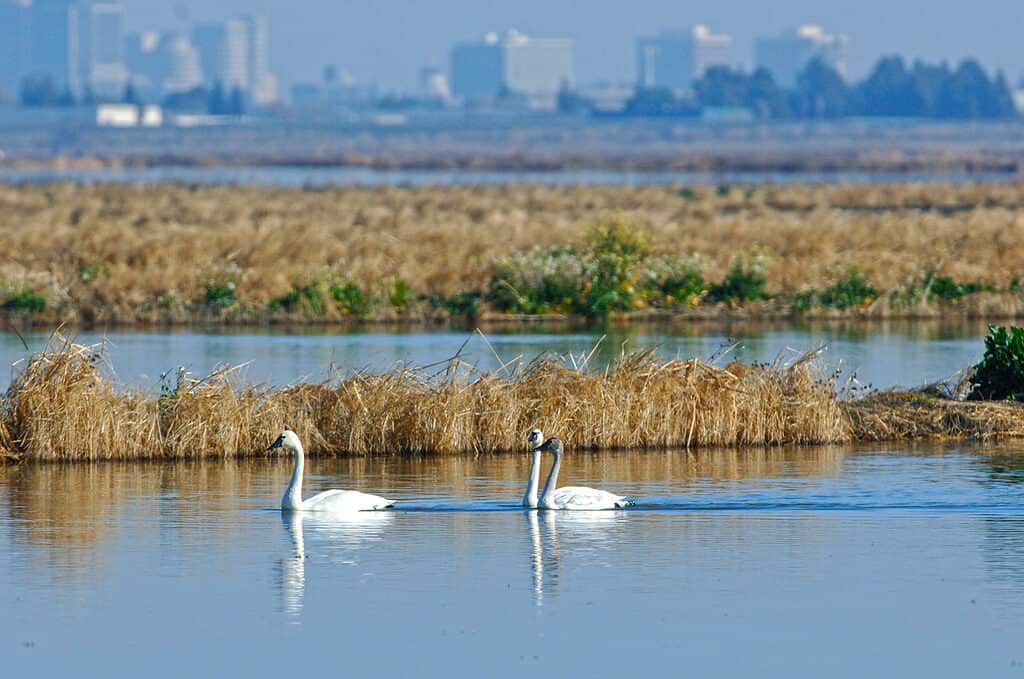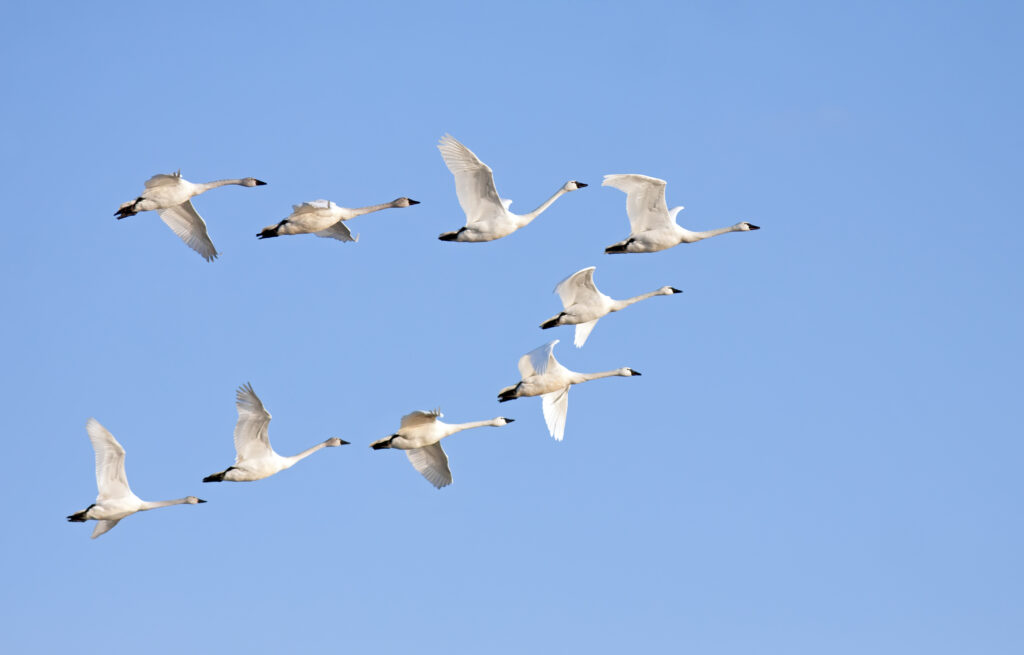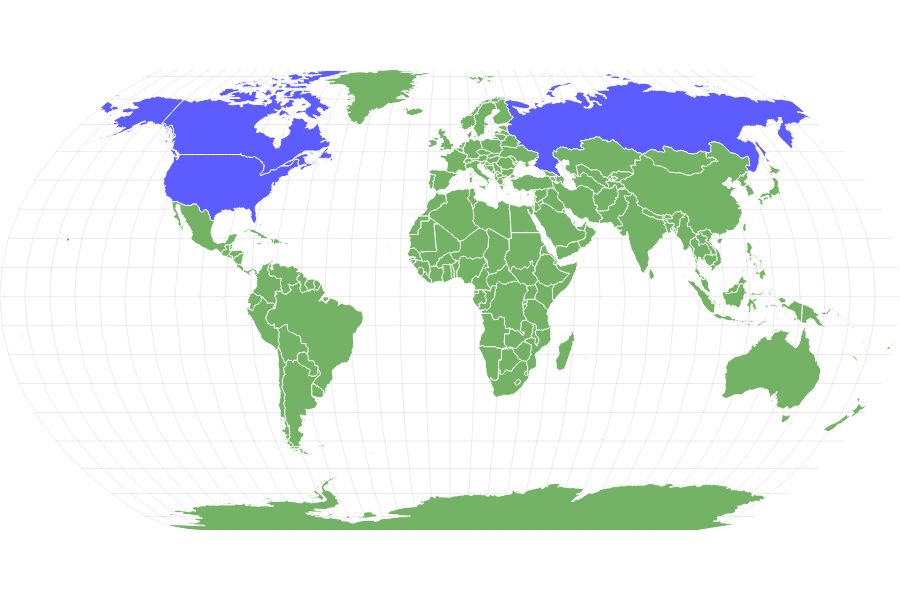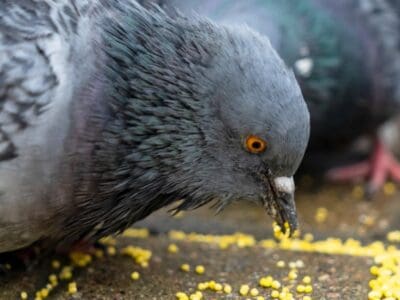Tundra Swan
Cygnus columbianus
“The tundra swan is entirely white except for a yellow marking at the base of their bill!”
Advertisement
Tundra Swan Scientific Classification
- Kingdom
- Animalia
- Phylum
- Chordata
- Class
- Aves
- Order
- Anseriformes
- Family
- Anatidae
- Genus
- Cygnus
- Scientific Name
- Cygnus columbianus
Read our Complete Guide to Classification of Animals.
Tundra Swan Conservation Status
Tundra Swan Facts
- Prey
- Mollusks
- Name Of Young
- Cygnets
- Group Behavior
- Flock
- Pair
- Fun Fact
- “The tundra swan is entirely white except for a yellow marking at the base of their bill!”
- Estimated Population Size
- 280,000
- Most Distinctive Feature
- Yellow marking at base of bill
- Wingspan
- 66.1 inches
- Incubation Period
- 31 to 32 days
- Age Of Fledgling
- 62 days
- Diet
- Omnivore
- Common Name
- Whistling swan, Bewick's swan
- Nesting Location
- Near water
- Migratory
- 1
View all of the Tundra Swan images!
“The tundra swan is entirely white except for a yellow marking at the base of their bill!”
The tundra swan is also known as the “whistling swan.” This is due to the distinct sound that their wings make in flight, a common name coined by Meriwether Lewis. They are found throughout the North Hemisphere, tending to breed in some of the coldest climates in the northern region of the world. This species is also known as the “Bewick’s swan,” although this name is typically given to the Eurasian population, while “whistling swan” often refers to the North American population.
Tundra Swan Amazing Facts
- This species is entirely white except for a black bill and an occasional yellow marking at the base of their bill.
- In the winter, this species will sleep almost entirely on water, a contrast from breeding nights spent on land.
- When large predators approach, incubating tundra swans will flee the nest to help disguise it.
- They find their life-long mates around two to three years old, whom they will nest with year-round.
Where to Find Tundra Swans
The tundra swan is a global species. It is found in North America, Asia, and Europe, with exact locations depending on the time of year. There are no significant year-round populations, with summers spent on the northernmost coast of Canada and Alaska, as well as Russia. Winters are spent mainly in Japan and on the eastern coast of China, with small populations on the western and eastern coasts of the United States and in Central Mexico.
During the summer, these birds can be found on lakes, ponds, and areas of wetlands and shorelines. During the fall and winter, they prefer to nest near brackish waters with close food sources.

Tundra swans are found in North America, Europe, and Asia.
©iStock.com/johnrandallalves
Tundra Swan Nests
Both the male and female swan in a pairing will contribute to the construction of the nest. Most often, these nests consist of vegetation, such as sedges, grasses, and mosses. The behaviors describing the nest building are known as “forward building” and “side building.” This describes how the pair usually searches within ten feet of the nest for materials. The female will then use her body to scrape away a bowl within the mound of vegetation. Since this is typically not large enough for the brood to incubate, both parents will then use their bills to deepen the bowl.
These birds build their nests near water. This can include areas such as islands or wet meadowlands on the northern coasts of North America and Eurasia. When possible, pairs will return to a nest in later breeding seasons.
Tundra Swan Scientific Name
The scientific name for the tundra swan is Cygnus columbianus. It is in the class Aves, which contains all species of birds. They are in the order Anseriformes and the family Anatidae. Their genus, Cygnus, contains all true swan species.
Tundra Swan Size, Appearance, and Behavior
The tundra swan is a rather large bird, although they are not the largest. These swans are larger in size compared to the snow goose, but they are smaller than the more common mute swans. Their length averages between 47.2 and 57.9 inches, and they can weigh 134.0 to 370.4 ounces. That is equal to approximately 8.4 pounds to 23.2 pounds. Adults have an average wingspan of 66.1 inches.
Tundra swans have long, elegant necks, as often seen in true swan species. Their plumage is entirely white, although, in some individuals, a yellow marking may be present at the base of the bill. As juveniles, you may notice that there is a greyish hue to the tundra swan’s neck, head, and wings. Their bills and legs are black. Sometimes, their feathers may become stained due to natural minerals and oxidation, giving them an orange appearance on their heads and necks.
When tundra swans are on the water, they will swim or float with their necks straightened. However, they may dip into the water to forage, as seen in dabbling ducks that do not completely submerge their bodies in pursuit of food. Tundra swans are known to form flocks. Oftentimes, these flocks are large. This is especially true during migration and wintering.
The terms “whistling swan” and “Bewick’s swan” both refer to the tundra swan. However, there are some variations in the individuals based on their locations. The Bewick’s swan, which is located in Eurasia, is often smaller than the American whistling swan. They also often have a larger yellow marking at the base of their bill. However, despite these regional differences in size and appearance, both are the same species.

The feathers of tundra swans are entirely white except for yellow markings at the base of their bills.
©hay_mn97/Shutterstock.com
Tundra Swan Migration Pattern and Timing
Tundra swans breed on the northernmost coasts of continental North America and Eurasia. This includes regions bordering the Arctic Ocean, Hudson Bay, Bering Sea, and Northwestern Passages. They winter on the western coasts of Eurasia. In North America, they winter in small regions along both the west and east coasts of the United States. The migration south to these wintering habitats begins in autumn, and they return north in the spring.
Tundra Swan Diet
The majority of the tundra swan’s diet is mainly made up of plant matter. However, they are also known to eat mollusks and arthropods. While they are wintering or en route to their wintering grounds, they may eat produce from agricultural fields. When pursuing prey such as mollusks, tundra swans will often have to compete with other birds, including gulls, that seek to steal their catches.
What Do Tundra Swans Eat?
The tundra swan has a diverse diet that includes the following:
- Clams
- Corn
- Rye
- Barley
- Tubers
- Stems
- Leaves
- Soybeans
- Rice
- Wheat
Tundra Swan Predators and Threats
This population is a relatively healthy one. Although they may not be the most common species due to their extreme habitats, they are considered to be one of the most numerous swans in North America. However, this is not to say that their population is without threats.
As with many game birds and scavengers, the tundra swan is threatened by lead poisoning. During hunting, lead shots may be dropped and accidentally consumed by foraging birds. Over time, this can lead to lead poisoning. This can also come from fishing sinkers and mining waste found in sediment.
There is also the concern of loss of habitat. Birds of this species have a limited range in which they thrive for both breeding and wintering. However, drilling and development have reduced the available habitats for these birds in some areas.
There are also natural threats to this species. This can include diseases, such as avian cholera, as well as predators. For many predators, adult birds will be able to defend themselves or their nest. However, when it comes to larger predators, such as bears or wolves, often, the best course of action is to flee the nest. But the parents aren’t abandoning their eggs. Instead, by flying away, the parents make it more difficult for the predators to find the nest. When the threat is gone, they will return to incubating and caring for their young.

Tundra swans are able to thrive in some of the most remote areas, although there are still threats to this species.
©Sergey Uryadnikov/Shutterstock.com
What Eats Tundra Swans?
Because they are found both on the water as well as on land, there are several different predators of this species. These include:
Tundra Swan Reproduction, Babies, and Lifespan
As mentioned above, these birds will find mates once they reach the age of 2 or 3 years old. These are their life-long mates.
Tundra swans will have one brood per year on average. Their clutch will typically contain between three to five eggs. The incubation period lasts between 31 and 32 days. Once the chicks, known as cygnets, hatch, they are covered in a light down with open eyes. Although they can walk and leave the nest within a few hours, it can take up to two months before they are able to fly.
This species has an average lifespan of around 10 years. However, the oldest tundra swan on record was 24 years old.
Tundra Swan Population
The tundra swan is a species of least concern. It is estimated that they have a global breeding population of 280,000.

Tundra swans are one of the most numerous swan species in North America.
©Delmas Lehman/Shutterstock.com
Thank you for reading! Have some feedback for us? Contact the AZ Animals editorial team.


















